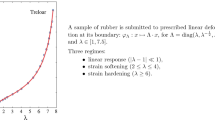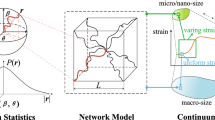Abstract
Constitutive equations are derived for the mechanical response of polymers at three-dimensional deformations with finite strains. A polymer is treated as an incompressible network of flexible chains with free ends whose motion at the micro-level is constrained by a random number of slip-links. The slip-links move affinely with macro-deformation, whereas chains can slide with respect to slip-links. When a free end of a chain slides through a slip-link, the slip-link disappears. Stress–strain relations are developed by using the laws of thermodynamics. They involve only one material constant with a transparent physical meaning.
Similar content being viewed by others
References
Treloar L.R.G. (1975) The physics of rubber elasticity. Clarendon Press, Oxford
Ward I.M. (1983) Mechanical properties of solid polymers. Wiley, New-York
Erman B., Mark J.E. (1998) Structures and properties of rubberlike networks. Oxford University Press, Oxford
Edwards S.F., Vilgis T.A. (1988) The tube model theory of rubber elasticity. Rep. Prog. Phys. 51, 243–297
Yeoh O.H., Fleming P.D. (1997) A new attempt to reconcile the statistical and phenomenological theories of rubber elasticity. J. Polym. Sci. Part B: Polym. Phys. 35, 1919–1931
Boyce M.C., Arruda E.M. (2000) Constitutive models of rubber elasticity A review. Rubber Chem. Technol. 73, 504–523
Rubinstein M., Panyukov S. (2002) Elasticity of polymer networks. Macromolecules 35, 6670–6686
Elias-Zuniga A., Beatty M.F. (2002) Constitutive equations for amended non-Gaussian network models of rubber elasticity. Int. J. Engng. Sci. 40, 2265–2294
Beatty M.F. (2003) An average-stretch full-network model for rubber elasticity. J. Elasticity 70, 65–86
Hartmann S., Tschope T., Schreiber L., Haupt P. (2003) Finite deformations of a carbon black-filled rubber. Experiment, optical measurement and material parameter identification using finite elements. Eur. J. Mech. A/Solids 22, 309–324
Attard M.M., Hunt G.W. (2004) Hyperelastic constitutive modeling under finite strain. Int. J. Solids Struct. 41, 5327–5350
Miehe C., Goktepe S., Lulei F. (2004) A micro-macro approach to rubber-like materials. I: The non-affine micro-sphere model of rubber elasticity. J. Mech. Phys. Solids 52, 2617–2660
Miroshnichenko D., Green W.A., Turner D.M. (2005) Composite and filament models for the mechanical behavior of elastomeric materials. J. Mech. Phys. Solids 53, 748–770
Doi M., Edwards S.F. (1978) Dynamics of concentrated polymer systems. 2. Molecular motion under flow. Faraday Trans. II 74, 1802–1817
Shanbhag S., Larson R.G. (2004) A slip-link model of branch-point motion in entangled polymers. Macromolecules 37, 8160–8166
Marrucci G., de Cindio B. (1980) The stress relaxation of molten PMMA at large deformations and its theoretical interpretation. Rheol. Acta. 19, 68–75
Ball R.C., Doi M., Edwards S.F., Warner M. (1981) Elasticity of entangled networks. Polymer 22, 1010–1018
Wagner M.H., Schaeffer J. (1992) Nonlinear strain measures for general biaxial extension of polymer melts. J. Rheol. 36, 1–26
Marrucci G., Greco F., Ianniruberto G. (2000) Simple strain measure for entangled polymers. J. Rheol. 44, 845–854
Greco F. (2002) The stress tensor in entangled polymers. Phys. Rev. Lett. 88, 108301
Greco F. (2004) Entangled polymeric liquids: nonstandard statistical thermodynamics of a subchain between entanglement points and a new calculation of the strain measure tensor. Macromolecules 37, 10079–10088
Schieber J.D. (2003) Fluctuations in entanglements of polymer liquids. J. Chem. Phys. 118, 5162–5166
Doi M., Edwards S.F. (1986) The theory of polymer dynamics. Clarendon Press, Oxford
Oberhettinger F., Badii L. (1973) Tables of Laplace Transforms. Springer, Berlin Heidelberg New York
Author information
Authors and Affiliations
Corresponding author
Additional information
Communicated by A. DeSimone
Rights and permissions
About this article
Cite this article
Drozdov, A.D. Polymer Networks with Slip-links: 1. Constitutive Equations for an Uncross-linked Network. Continuum Mech. Thermodyn. 18, 157–170 (2006). https://doi.org/10.1007/s00161-006-0020-y
Received:
Accepted:
Published:
Issue Date:
DOI: https://doi.org/10.1007/s00161-006-0020-y




